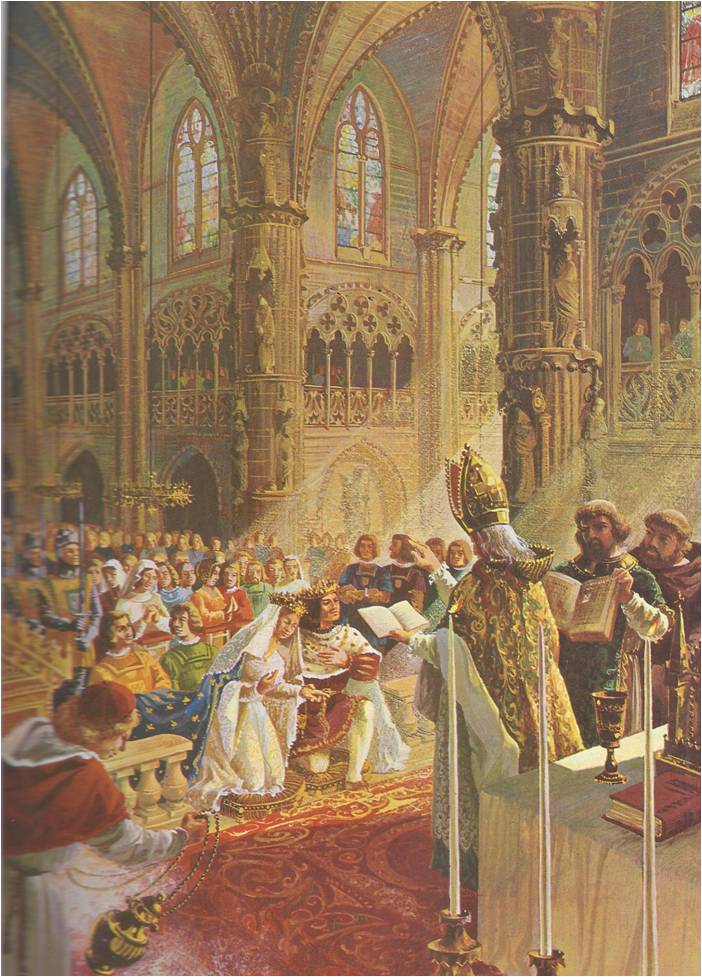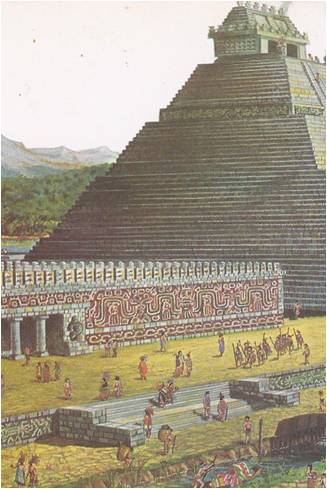VETERANS or the Union Army, returning to their home towns in New England or the Middle Atlantic states after the war were surprised at what they saw. They had grown up in towns where most of the people lived by farming, while the rest sold things to farmers or worked in local workshops. Perhaps a mill and a factory had stood on the bank of the town’s river. The farms, stores and workshops remained, but now there were many new brick buildings used for factories, mills and warehouses. American industry, concentrated in the river valleys and ocean ports of the northeast, had grown with a rush during the Civil War. Behind the fighting lines, factories had turned out rails and telegraph wires, rifles and bullets, boots, uniforms, blankets, tents — all the articles needed for the Union forces. These products of Northern industry made a big difference on the battlefields. Before the war, the South had been an agricultural land, with large plantations worked by slaves and smaller farms worked by poor white farmers. Cotton was the big crop and great quantities of it were sold, especially to the mills of Great Britain. The wealth of the South, based on the unpaid labour of slaves, had given it as much influence within the nation as the North, which was partly agricultural and partly industrial. The South had little industry. When war came, it was unable to keep its fighting men supplied with weapons and other needs. The ill-equipped Southerners were worn down by the well-equipped Northerners, until finally they were completely defeated. The victory of the Union upset the balance of power between the North and the South. With the freeing of the slaves, most of the Southern planters were ruined, while the leaders of industry in the North were …
Read More »Democracy and Nationalism 1815-1848
WHILE THE Industrial Revolution was transforming England and creating a new kind of society, the continent of Europe seemed to be going backward instead of forward. After Napoleon’s defeat in 1815, the monarchs and aristocrats brought back the principle of “legitimacy.” Legitimacy meant that only kings, aristocrats and the established church had the right to rule and that the people must obey them without question. The American and French revolutions had been fought to overthrow the principle of legitimacy. The idea behind these revolutions was that governments were created by the people. As the Declaration of Independence put it, all men were born equal and had the right to “life, liberty and the pursuit of happiness”– and governments were set up to help them secure these rights. Legitimacy and the ideas of the revolutions were completely opposed to each other. At first it looked as though legitimacy would win out, at least in Europe. In 1814, the four nations that had defeated Napoleon — Austria, Russia, Prussia and Britain — met in a peace conference called the Congress of Vienna. They gave the throne of France to Louis XVIII. They changed the map of Europe to produce a balance of power that is, groupings of states that were roughly equal to each other in strength. They saw to it that Germany and Italy were divided and did not become great and united nations. To carry out their agreements and keep down revolution, Austria, Russia, Prussia and Britain formed what was known as the Quadruple Alliance. Later, in 1818, they became allied with France and formed the Quintuple Alliance. The British, however, did not support all the policies of the alliance; they believed that every country had the right to change its form of government. The result was that Austria, Russia …
Read More »Ferdinand and Isabella Unite Spain 1469-1700
IT WAS Wednesday, October 18, 1469 and Princess Isabella of Castile and Prince Ferdinand of Aragon were being married. At the end of the beautiful ceremony, the two thousand guests cheered and the entire city of Valladolid began a week of celebration. Isabella was overjoyed, for she loved her husband and he loved her. They seemed well matched. Isabella was eighteen, tall, blonde and blue-eyed – “The handsomest lady I ever beheld‚” one nobleman said. Ferdinand was slightly shorter than his wife, but he was handsome. Isabella was intelligent, very religious and strong-willed. Ferdinand, too, was intelligent and he was extremely shrewd. The happy couple talked for long hours, went riding, played chess and their love grew. Isabella was glad to escape from the royal court of her brother, King Henry IV of Castile. Castile was the largest of the several kingdoms that made up Spain and under Henry IV it was probably the worst ruled. Isabella hated Henry’s court. The nobles were proud, ignorant and insolent; some were fierce warriors, the rest seemed lazy. Most of them taxed their peasants harshly, then spent the money on magnificent lace-trimmed clothes, on drinking and fighting. King Henry himself set a bad example. He was cruel, he loved to watch spectacles and fires, he let his guard of wild Moorish soldiers insult the young Spanish ladies. When their fathers complained, he told them they were insane and had them whipped in public. The nobles could get anything they wanted from Henry. Sometimes he gave them blank checks to take any sum they wished from Castile’s treasury. Henry was a weak king and became known as Henry the impotent. In the provinces, the nobles were even more unruly. Around Seville, the Duke of Medina-Sidonia and the hot-headed Marquis of Cadiz were at war, …
Read More »Adventures in the New World 1519 – 1620
“I DID NOT come to till the soil like a peasant,” said Hernando Cortez. “I came to find gold.” His words echoed the thoughts of almost every Spaniard in the New World. The discovery of the sea route to the West had set off a great treasure hunt. Colonizing and slaughtering, building and plundering, the gold-hungry Spaniards won a Spanish Empire of the West. Conquistadores‚ they were called — the conquerors. None of the treasure-hunters was more cunning or ambitious than Hernando Cortez‚ who came to the island of Hispaniola in 1504. It was not until 1519 that the governor of Hispaniola sent him on an expedition to explore the coast of Central America. Cortez sailed with five ships, 500 soldiers, eleven cannon and fifteen horses. The fleet anchored near the coast of the territory called Mexico and the men went ashore to build a settlement. Cortez ordered the ships dismantled so that none of his men could go back to Hispaniola, then set off on a march inland. Mexico was a vast country whose Indians had built a highly organized civilization and Cortez had a force of less than 500 men. He was a skillful leader; besides, he had firearms and horses –and good luck. Not long after he began his march, a horde of Indians swept out of the hills to attack the Spaniards. As soon as the Spanish cavalry appeared, the Indians fled to safety. As one soldier later wrote, the Indians, “who had never before seen a horse, thought that steed and rider were one creature.” One tribe after another surrendered. They had been conquered by the people called the Aztecs and many of them offered to join Cortez in the fight to destroy the Aztec empire. As the Spaniards and their Indian allies pushed on …
Read More »Preachers of Reform 1518-1564
IN 1518, AN INDULGENCE PEDDLER, a priest from France, made his way through one of the twisting Alpine passes that led into Switzerland. He carried with him a supply of bright banners, an impressive-looking copy of Pope Leo’s Declaration of Indulgences and of course, a collecting box. The French priest’s hopes were high, for the little Swiss merchant towns were rich. He did indeed do well at first and his collecting box began to grow heavy with pieces of gold. Then he came to the town of Zurich. As he began to set up his banners, a town official stopped him. “No indulgences here,” the official said. “I come in the name of Pope Leo and the Holy Church,” the Frenchman replied. “And I,” said the official, “speak for the town council of Zurich and the People’s Priest of our Cathedral who has told us that these indulgences you peddle are no good.” When the Frenchman began to protest, the official said he would have him driven out of town if he didn’t leave peacefully. The Frenchman rolled up his bright banners and went on his way. The Swiss, he knew‚ had always been too independent and now, with this People’s Priest, whoever he was, they seemed to have found another Martin Luther. Actually, nothing so annoyed the People’s Priest of Zurich as being called the “other Luther.” Ulrich Zwingli said that his ideas were his own and that he had come upon them long before Luther began to make a stir in Wittenberg. As a young parish priest‚ fresh from the university, Zwingli had studied Greek and Hebrew in order to read the Bible and other early church writings in their original languages. Three times he had gone to Italy, as chaplain to the rugged Swiss soldiers who were …
Read More »




